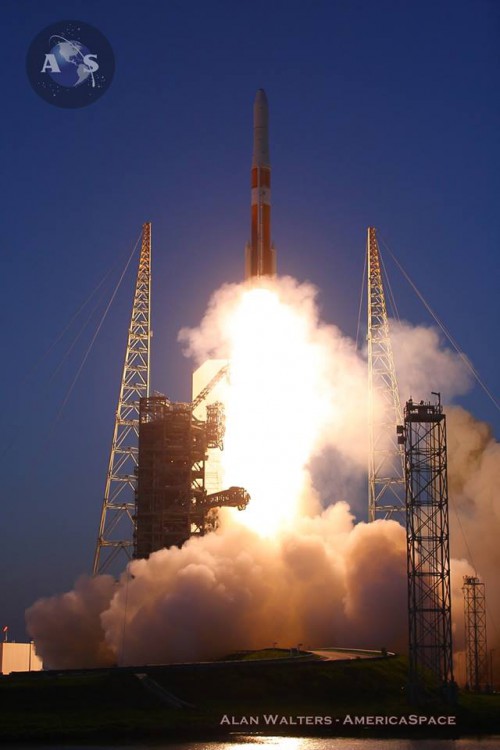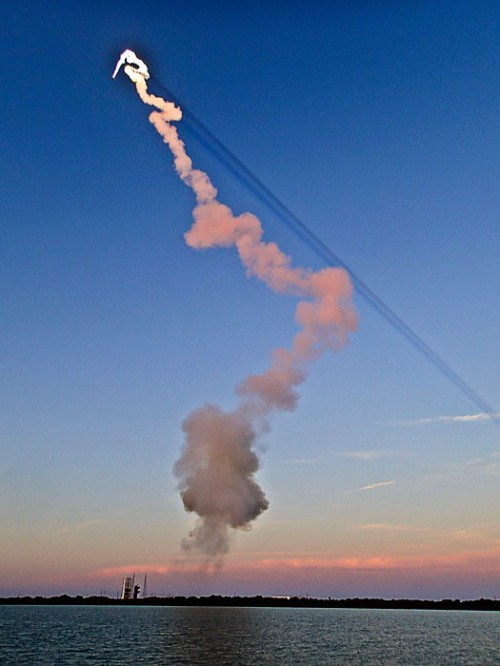
A beautiful Florida sunset was outdone by a United Launch Alliance (ULA) Delta-IV rocket last night with the successful delivery of the next Global Positioning System (GPS) IIF satellite to a semi-synchronous 11,000-mile-high circular orbit for the U.S. Air Force, and AmericaSpace was, like always, there to cover the action. Liftoff of the 200-plus-foot-tall rocket occurred as expected at 8:03 p.m. EDT from Cape Canaveral Air Force Station Space Launch Complex-37, marking the Delta-IV’s 26th flight and kicking off ULA’s fifth launch of 2014 (82nd overall). The mission also marks ULA’s 32nd launch for the U.S. Air Force and the 53rd operational GPS satellite launch on a ULA Rocket.
“ULA is honored to work with this world-class U.S. government and contractor mission team, and we are proud to contribute to the GPS capabilities that were delivered to orbit today,” said Jim Sponnick, ULA vice president, Atlas and Delta Programs. “Congratulations to the entire team on tonight’s successful launch of the GPS IIF-6 satellite and the continued one-launch-at-a-time focus.”

The 3,600-pound next generation GPS satellite, designated GPS IIF-6, is the sixth member of the planned 12-strong constellation of Block IIF satellites first launched in May 2010; the latest in an “interim” class of GPS satellites to keep a critical worldwide positioning, velocity, and timing asset operational until the next-generation GPS Block IIIA comes online later in 2014. They continuously transmit digital radio signals pertaining to the exact time, using atomic clocks, and exact location of the satellites. Each GPS IIF satellite is designed to remain operational for 12 years.
The spacecraft boasts improved-accuracy positioning systems, a reprogrammable processor capable of future upgrades, an interference-free civilian signal for commercial aviation search-and-rescue, and better resistance to electronic jamming through the new “M-code” military GPS signal.
“As each IIF satellite becomes operational, we continue the seamless transformation of the GPS constellation into an even more accurate, reliable, and durable navigation resource for the U.S. military and the global civilian user community,” said Craig Cooning, vice president and general manager of GPS Block IIF prime contractor Boeing Space & Intelligence Systems. “Our efficient pulse-line manufacturing process, adapted from Boeing’s commercial airplane production lines, also ensures that we deliver each spacecraft on time and on cost.”
As outlined in ULA’s GPS IIF-6 Mission Overview: “GPS utilizes 24 satellites, in six different planes, with a minimum of four satellites per plane, positioned in orbit approximately 11,000 miles above the Earth’s surface. The satellites continuously transmit digital radio signals pertaining to the exact time (using atomic clocks) and exact location of the satellites. The GPS IIF series have a design life of 12 years. With the proper equipment, users can receive these signals to calculate time, location, and velocity. The signals are so accurate that time can be measured to within a millionth of a second, velocity within a fraction of a mile per hour, and location to within feet. Receivers have been developed for use in aircraft, ships, land vehicles, and to hand carry.”
The launch itself was by the book, with ignition of the vehicle’s single Aerojet Rocketdyne RS-68 liquid oxygen and hydrogen engine producing 663,000 pounds of propulsive yield at T-5 seconds. The command to fire the ATK-made GEM-60 boosters occurred at T-0.01 seconds, and release of the hold-down clamps occurred at T-0, letting the Delta-IV fly atop a brilliant pillar of fire out over the Atlantic Ocean. Following liftoff, the launcher then performed an automated pitch, yaw, and roll program maneuver to establish itself on the proper 44.55-degree flight azimuth, roaring toward space and shattering the sound barrier at T+47 seconds as it continued to accelerate skyward.

The boosters were jettisoned at about T+100 seconds, at which point the RS-68 engine continued to fire for another three minutes to propel the stack toward orbit. At T+4:15 seconds the RS-68 had done its job, allowing for ignition of the second stage Pratt & Whitney Rocketdyne RL-10B2 engine and its 24,750 pounds of thrust to continue pushing GPS IIF-6 toward orbit for another 15 minutes and 30 seconds, at which point the RL-10B2 engine achieved an initial, elliptical “parking orbit” and shut down.
Approximately 3 hours and 3 minutes into the mission the RL-10B2 ignited again for its second burn, which lasted a little under 2 minutes to position GPS IIF-6 correctly for separation from its 38.5-foot-long Payload Attach Fitting (PAF) at about 3 hours, 15 minutes, and 50 seconds into the flight.
The U.S. Air Force awarded Lockheed Martin a $1.4 billion contract in May 2008 to develop the Block IIIA network, which may eventually consist of as many as 32 satellites. At present, the Air Force has formally contracted for four Block IIIAs. With 500 times the transmitter power of current systems, Block IIIA will also benefit from new navigational warfare capabilities, enabling them to shut off GPS service to limited geographical locations whilst maintaining service to U.S. and allied forces. The system is operated and controlled by the 50th Space Wing, located at Schriever Air Force Base, Colo.
With GPS IIF-6 delivered to orbit ULA and the U.S. Air Force can now focus on launching GPS IIF-7 in late July and GPS IIF-8 in October. Both will be lofted by ULA’s Atlas V 401 boosters from Space Launch Complex (SLC)-41 at Cape Canaveral Air Force Station.
BELOW: Photos from the GPS IIF-6 Launch May 16, 2014. All Photos copyright 2014 Alan Walters, John Studwell, and William Matt Gaetjens for AmericaSpace, all rights reserved.


– Want to keep up-to-date with all things space? Be sure to “Like” AmericaSpace on Facebook and follow us on Twitter: @AmericaSpace
Missions » GPS » Missions » GPS » GPS IIF-6 »

















Great photos!